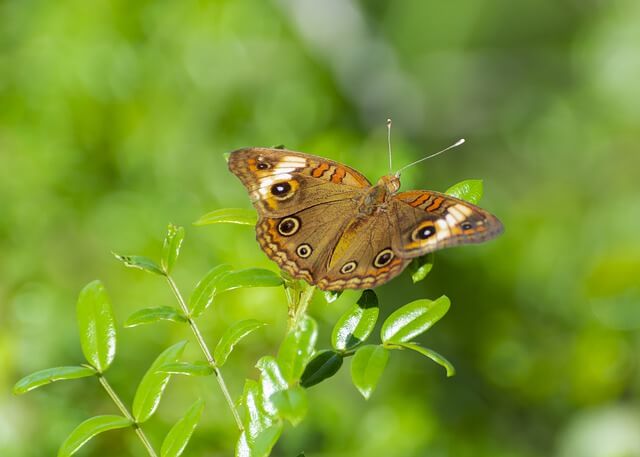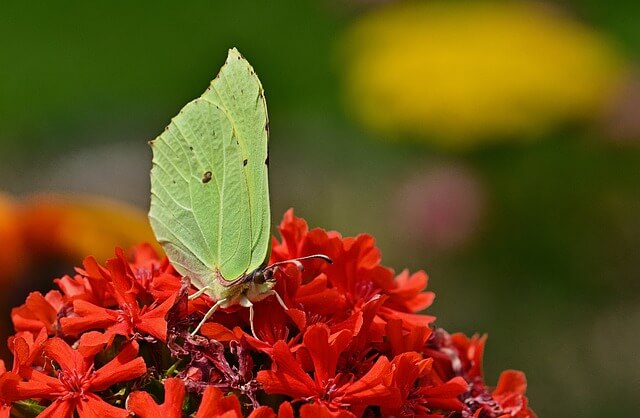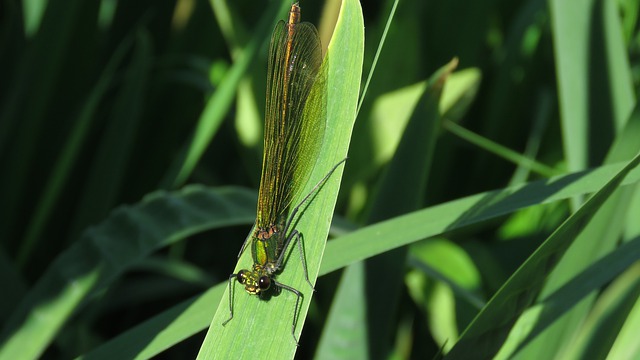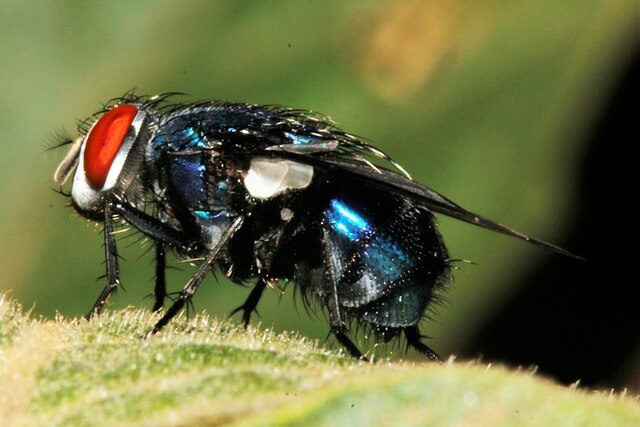What is the feeding, defense and coloration habits of insects? Information on active defenses, mobility, flight and migration of insects.
Feeding.
Adult insects with chewing mouth-parts, such as cockroaches and ants, are general feeders, eating a wide variety of plant and animal matter. Plant-eating and parasitic insects are the most restricted feeders, sometimes feeding on only one species of plant or animal. Many carnivorous insects eat other insects, including members of their own species. A tremendous number of insects at all stages of their life cycle are saprophagous, feeding only on the products of organic decay.
Very few insects can digest cellulose, the material that makes up the celi walls of plant cells. Termites and a few other insects have certain cellulose-digesting protozoa in their digestive tract. Other plant-eating insects do not digest cellulose, but either suck the plant sap or digest only the contents of the cells, excreting the cellulose undigested.

Source: pixabay.com
Some insects, such as houseflies, predigest their food by pouring saliva over it before it is eaten. Another type of predigested food is honey-dew, the sweet excretion of aphids. Honeydew is rich in carbohydrates as well as amino acids (components of proteins) and a few trace elements. It is eagerly sought by many insects, who sometimes stroke the aphids to hasten the excretion of honeydew.
Defenses.
insects are preyed upon by a wide variety of animals. Some insects depend on their speed and agility for escaping from predators and many have various defense mechanisms for warding off their enemies. Some insects are protected by spines, stings, and other devices, but most insects rely heavily on their coloration to protect them from predators. Coloration is said to be a passive defense, while spines and similar devices are said to be active defense mechanisms.
Coloration.
Adaptive coloration is generally divided into two broad categories: cryptic, or concealment, coloration, and aposematic, or warning, coloration. Cryptic coloration makes an insect less conspicuous against a particular background either by closely imitating the background or by confusing the outline of the insect against the background.
Aposematic coloration may be divided into two types. One is a simple device to frighten off potential enemies by invoking an alarm reaction. The second type of aposematic coloration is called mimicry. Generally, there are two major forms of mimicry. Batesian mimicry, which is named for the English naturalist Henry Bates, is thought to give protection to an innocuous insect that assumes the color and pattern of a dangerous or unpalatable species. Müllerian mimicry, which is named for the German entomologist Fritz Müller, refers to a more general situation in which a number of different insects share a common appearance and are said to derive some advantage from this in that the attacks of predators are shared by all of them.

Source: pixabay.com
Active Defenses.
Both chewing and sucking insects use their mouthparts for defense, and the socalled bite of an insect is often a piercing or stabbing with the proboscis. Stinging is another familiar type of insect defense, in which the female insect inserts her modified ovipositor into the tissues of an animal and releases certain toxic substances. Stinging is characteristic of certain bees, ants, and wasps, which have ceased to use their ovipositor for the purpose of laying eggs but use it as a weapon against insect enemies or other, larger animals that may threaten them. Stinging is also used for immobilizing prey.
Many insects also have special glands that are derived from the cuticle and that produce a variety of poisonous chemical substances. Many caterpillars have barbed hairs, called urticating hairs, which are connected to glands that produce substances irritating to the skin. Other glands, called repugnatorial glands, produce substances with an unpleasant odor that repels other insects. These so-called stink glands are most commonly found in bugs, beetles, and caterpillars. Bombardier beetles expel a fluid that may contain formic acid or iodine; the fluid is expelled from their abdominal glands with such force that it appears as a cloud of mist. Reflex bleeding is a curious active defense mechanism of certain beetles. When attacked, the beetles squeeze out drops of blood through the joints in their body or legs. The blood has such a nasty taste that the predator is repelled.
Mobility and Flight.
In general, insects with well-developed legs and chewing mouthparts are active predators and run about rather than fly. Some flying predators, however, such as dragon-flies and robber flies, have powerful legs for seizing and holding their prey. Chewing insects are generally more active than sucking insects, which tend to remain in one position when they are not flying from one meal to the next. Thus, on a single plant there may. be hundreds of aphids sucking the plant sap and remaining stationary while some of them are being devoured by roving predators, such as the fervae of ladybird beetles, lacewings, and syrphid, or flower, flies.
The sedentary habit is carried to the extreme in the female scale insects, which are active only during their first nymphal stage and then spend the rest of their lives attached to a plant. Male scale insects have wings and fly about actively. A modification similar to that of the female scale insect occurs in parasitic insects, notably the female of the fly Ascodipterorı, which lives buried in the skin of a bat. This female does develop wings, but upon reaching a host, she loses her legs and wings and buries herself in the host’s skin while her abdomen enlarges into a huge sac filled with eggs. This enlargement of the abdomen, known as physogastry, occurs in many insects. The best-known example of this phenomenon occurs in the female queen termite, whose abdomen may reach a length of several inches and contain hundreds of eggs. Other examples of physogastry are seen in jigger fleas, queen ants, and many unrelated insects that inhabit ant nests, including various beetles and flies.

Source: pixabay.com
Insects fly by beating their wings up and down. This motion is controlled by the powerful indirect muscles of the thorax, which are stimulated by the nervous system. The nervous system also stimulates the direct muscles, which twist and flex the wings to provide control and direction. The number of wing beats per second varies greatly among insects—it is directly related to the strength of the wing muscles and the weight of the insect. Butterflies, which generally have large wings and light bodies, may beat their wings from 4 to 20 times a second while flies and bees, which have heavier bodies and smaller wings, may beat their wings 100 times a second. It is estimated that mosquitoes may beat their wings up and down as much as 1,000 times in a second.
Although many insects are capable of sudden bursts of speed, they generally cannot sustain them for long periods. The greatest speed at which an insect can fly is about 35 miles (56 km) per hour, a speed that can be attained by certain dragonflies. Most common insects may reach a speed of only about 5 to 8 miles (8-12.8 km) an hour.
Migration.
Although many insects tend to remain in one region, others may become widely dispersed by means of periodic migrations. This tendency to disperse into larger and more varied environments has been one of the main factors in the successful habitation by insects of so much of the earth’s usable surface. Most insects migrate by flying from one area to another, but a îew species, including the processionary moths and the army and driver ants, travel in groups over ground.
Migratory movements generally take place early in the insect’s adult life, as soon as it is ready for sustained flight. The number of insects involved in a migration flight is generally very large. A locust swarm often consists of a billion individuals and a flight of painted lady butterflies in California was once estimated to consist of 3 billion individuals.
The dispersal of insects by air is sometimes divided into two types, active and passive, although some authorities disagree with this distinction. Passive migrations occur in many small insects, such as aphids, scale insects, and caterpillars, which may be carried up into the air and transported considerable distances by storms or by the general movement of air currents. The migration flight of desert locusts is also an example of passive migration. The actual flying movements of the insects are aimed at keeping the swarm together while the swarm as a whole is carried by the wind. The migration flight ends when the swarm arrives in an area of low atmospheric pressure, which indicates that rain may soon fail, making the ground suitable for the locusts to deposit their eggs.

Source: pixabay.com
An example of active migration is the migration of butterflies, which takes them from one breeding ground to another or away from a breeding ground when the weather is too cold or during a drought. The butterflies are not simply carried by the wind, but fly in a definite direction at certain times of the year. Sometimes, there is a reverse migratory movement in which the same individuals or those of the next generation return to the original site. The North American monarch butterfly is probably the most famous insect migrant. In the fail, swarms of monarchs fly from the northern United States and Canada to the Gulf Coast and Mexico and during the trip they alight and feed daily. In the spring they fly in the reverse direction, heading north, and they do not stop to feed along the way.
Function Of Abdominal Appendages Of Insects
The modified appendages of the eighth and ninth abdominal segments form the external genitalia. The nıale genitalia are usually very complex, consisting of a pair of claspers and a structure for introducing sperm into the body of the female. The female external sex organ is the ovipositor, which varies in shape according to the insect’s method of laying eggs. For example, insects that lay eggs by simply dropping them into water or onto the ground have only a small opening regulated by valves.
Insects that insert their eggs into plants or animals or push them into the soil have a long tubular ovipositor. In many insects the abdomen terminates in a pair of simple or segmented cerei, structures that serve as feelers. In some groups, sueh as grasshoppers, they are simple padlike structures, but in others, including the eanvigs, they are large and pincerlike.
External Features Of Insects
Insects belong to the phylum Arthropoda and share a number of characteristics with other arthropods. Like lobsters, spiders, ticks, and other arthropods, insects are characterized by jointed legs and other appendages, a segmented body, and a tough body covering that serves as the animal’s skeleton. Unlike other arthropods, adult insects never have more than three pairs of legs, usually have two pairs of wings, and have a body that is divided into three distinct parts: a head, a thorax, and an abdomen. Arising from these basic body divisions are the various appendages.
The appendages arising from the head are the antennae and the mouthparts, and those arising from the thorax are the legs. It is believed that the primitive ancestors of insects had one pair of appendages on each abdominal segment, and a few living insects, such as the bristletails, still have many abdominal appendages. Most other living insects, however, do not have true appendages on the abdomen but have modified appendages that are the external genital organs and the cerci, structures that serve as touch receptors. The wings of insects are not appendages but are outgrowths of the body covering, or cuticle.
mavi